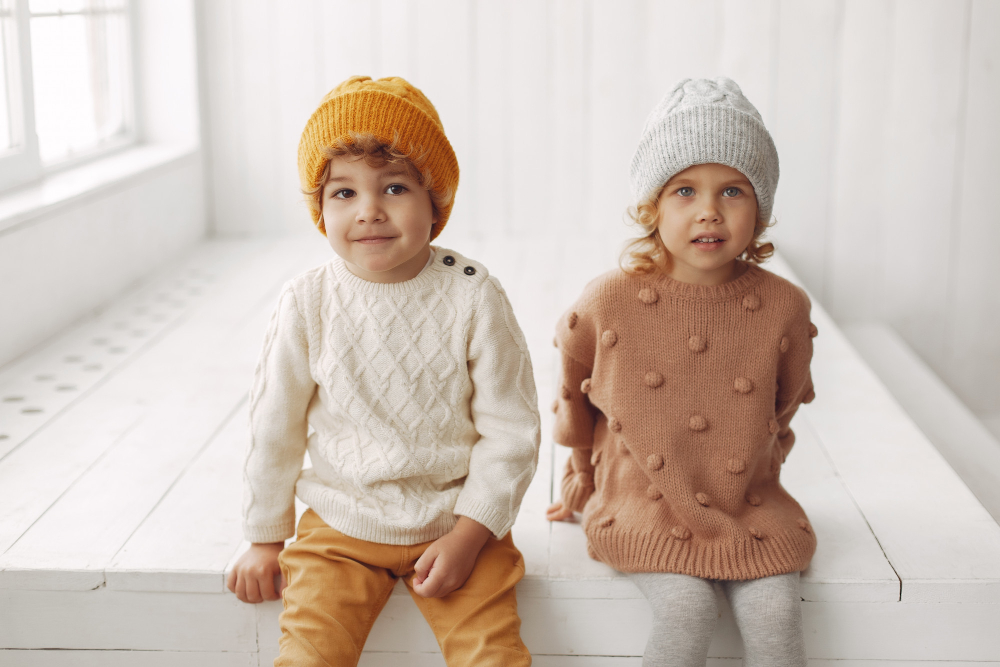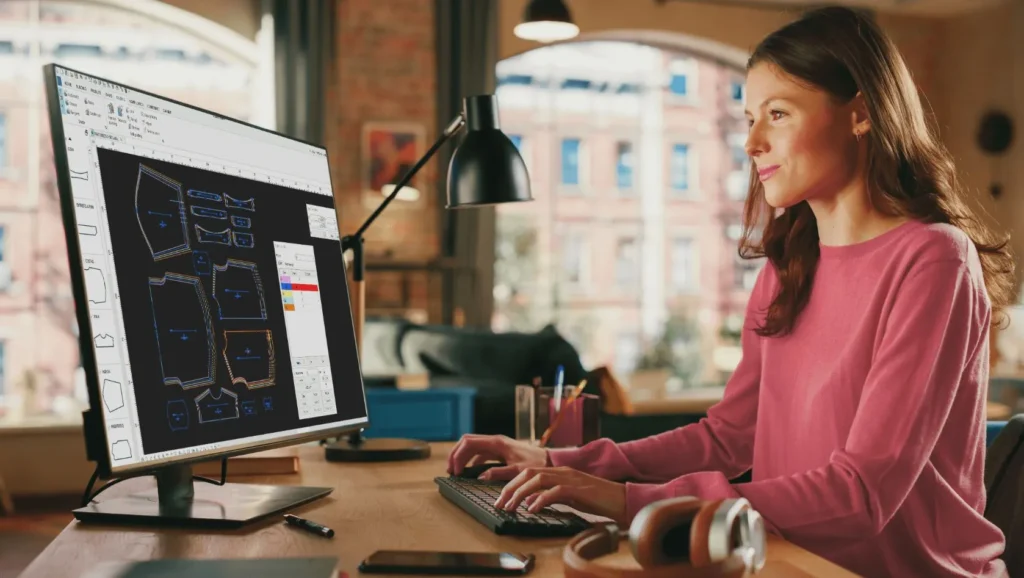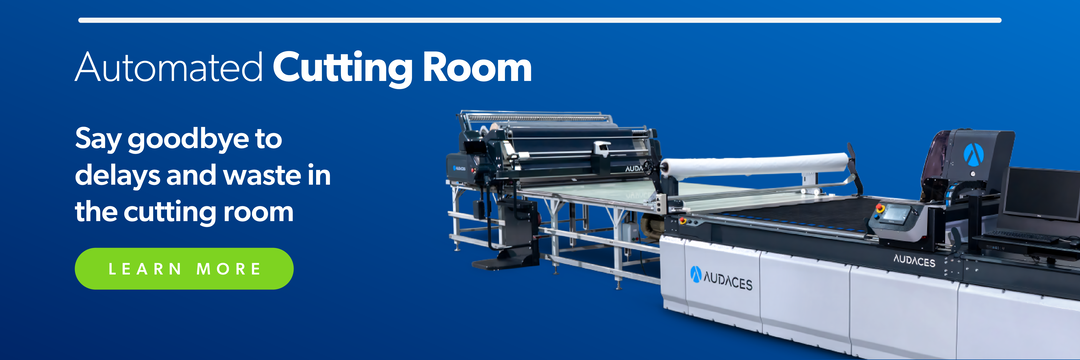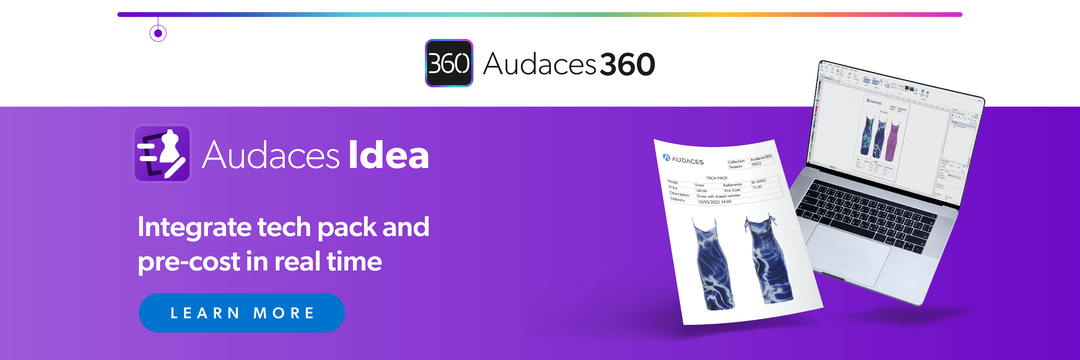Summary
- Pattern makers know that every detail matters when it comes to functionality for kids patterns.
- By rethinking how you approach certain tasks, you can free up more space for creativity.
- Stand out in the fashion world with Audaces360 technology. Start your free trial now!
Creating kids patterns comes with unique challenges and creative rewards. After all, designing for children isn’t just about scaling down adult styles. It’s about understanding movement, comfort, and fast-changing sizes.
In the busy routine of developing kidswear, it can be easy to fall into the same methods that slow down the process. That’s why looking for new ways to organize and plan your work can make such a difference.
That’s why we are bringing you practical tips to help you simplify and speed up your kids patterns creation. We hope these suggestions inspire you and bring new energy to your daily routine.
Happy reading!
Sumário
Why is it so important to get kids patterns right?
Designing clothes for children is very different from designing for adults. This is because kids grow quickly and move in ways that demand extra comfort. For this reason, you must carefully plan these pieces to fit well and allow freedom of movement.
Getting kids patterns right also helps avoid common mistakes. For example, clothes that are too tight or too loose can cause discomfort. When patterns are precise, the final garments look better and feel better to wear.
Another point to consider is safety. Well-made patterns help keep buttons, zippers, and seams in the right places, reducing the risk of scratching or irritating a child’s skin.
Attention to detail also makes production smoother. Clear and accurate sewing patterns save time and materials, which is especially important in large-scale production. This keeps costs under control while maintaining quality.
4 must-know tips for producing kids patterns
We’ve gathered these 4 tips to help you design better patterns for kids, avoid common mistakes, and make your work more efficient.
By following them, you can create pieces that look good, wear well, and make your process smoother.
Let’s explore each tip in detail!
1) Design with comfort and movement in mind
One thing is true: children rarely sit still. They run, jump, and stretch in every direction.
This is why kids patterns need to do more than look cute: they must allow real freedom of movement.
Think about adding a little extra ease around key points like shoulders, elbows, and knees. This helps clothes stay comfortable when kids move and play, avoiding tight fits that could restrict them.
Fabrics also matter. Choose soft, flexible materials that can handle daily wear. Combine this with clever pattern choices, like raglan sleeves or elastic waistbands, to make dressing easier.
It’s also important to test your designs. Try 3D sewing a prototype and check if it fits well in action, not just when standing still. Adjustments at this stage can save time later.
Learn more: Why simulate the 3D fit of garments before production?
2) Pay close attention to every new measurement

Children grow quickly, and size charts alone aren’t always enough. That’s why updating your measurements often is essential when working with kids patterns.
Even small changes in height or body shape can affect how clothes fit. Measure chest, waist, hips, and other key points before starting a new pattern or collection. Keep these records organized and date them clearly.
If possible, work with fit models who match your target sizes. Fitting real samples on real kids helps catch issues that numbers alone might miss.
When you keep your measurements fresh and accurate, you protect the quality and comfort of every piece you design.
Learn more: Discover how to craft a custom kids’ clothing size chart
3) Handle patterns with stripes carefully
Stripes look great in kidswear, adding a playful touch, but they add complexity to patternmaking. To keep your designs clean and professional, pay special attention to how stripes line up.
Start by marking the stripe direction on your sewing patterns. This makes it easier to place pattern pieces on the fabric correctly. Aim for side seams and sleeves where stripes match up neatly.
Moreover, be careful with curved pieces like collars or pockets. Stripes can distort easily in these areas. Sometimes, it’s better to cut these parts on the bias or choose solid fabrics to avoid mismatches.
Finally, consider the width of the stripes. Wide stripes are easier to align than very narrow ones.
4) Create your patterns entirely online
Digital patternmaking brings speed and precision to your work. By creating kids patterns directly on the computer, you can test ideas faster and make changes easily.
With the right software, you can store, copy, and adjust your designs without starting from scratch. It will help you keep your work organized and ready for new collections.
You can also run virtual fittings and see how a pattern behaves before cutting any fabric. This reduces waste and makes the process more sustainable.
How to make kids patterns directly on your computer?

Choose the system that best fits your needs
Start by researching different software options for digital patternmaking. Think about what matters most to you.
Do you need tools for grading sizes quickly? Or maybe you want 3D simulation to see how the garment fits? List your needs before making a choice.
Also, check if the software works well with other solutions you use. Compatibility saves time and avoids file issues later.
If possible, try a free trial or demo version first. This helps you see if the system feels intuitive and meets your daily demands.
Learn to use all the tools available
Once you pick a system, spend time exploring every tool it offers. Many professionals end up only using basic functions at first, but advanced tools can save hours of work.
Look for tutorials, guides, or online courses from the software provider. They often show time-saving tips that aren’t obvious at first glance. Practice by creating simple kids patterns first. This helps you build confidence and test how tools work together.
The more you know about your tools, the easier it becomes to turn ideas into finished patterns.
All you need to master kids pattern creation is in Audaces solutions. Download our exclusive guide and discover how our digital patternmaking tools can transform your work!
Gather all the necessary measurements
Accurate measurements are the base of any successful kids pattern. Children grow quickly, so it’s important to use recent data whenever possible.
Measure chest, waist, hips, and other areas that affect fit. For kidswear, also include special points like sleeve length and rise for pants.
Keep these measurements organized in a file or chart. Specialized digital systems let you save size tables directly inside the software.
Learn more: Essential tips on how to take body measurements
Make adjustments and simulate the finished garment
One of the biggest advantages of digital patternmaking is easy editing. If a part doesn’t look right, you can adjust curves or add seam allowances quickly.
Furthermore, using the software’s grading tools makes creating different sizes easy, saving time compared to manual grading.
If your system includes 3D simulation, you can even test how the garment looks on a virtual child model. This helps you spot tight areas or design issues before cutting any fabric.
Simulation also helps communicate ideas to your team or clients. Seeing a nearly finished look on screen is clearer than flat sketches.
Learn more: Why simulate the 3D fit of garments before production?
Check details and finishing touches
Before exporting your kids patterns, take time to review small details. Make sure notches, grainlines, and seam allowances are clear.
Remember to check pattern names and piece labels to avoid confusion during cutting and sewing. This is especially important in kidswear, where pieces can be small and similar.
Review finishing elements like hems, elastic channels, and pocket placements. Clear instructions make production smoother and reduce mistakes. Attention to detail shows professionalism and helps your designs come to life exactly as planned.
Export and print your ready-to-use patterns
When you’re sure your kids patterns look complete, export them in the right format. Many systems let you choose between PDF, DXF, or other formats your team or factory needs.
Before printing, check scale settings to ensure the pattern size stays correct. A small print error can affect the whole garment fit.
Print a test page to confirm everything matches your plan. Adjust if needed, then print the final patterns on large-format paper or send files directly to cutting machines.
Store the digital files safely, using clear names and folders by style or season. This makes it easier to reuse or update designs later.
By organizing your patterns well, you finish the process with files that are production-ready and easy to share.
Learn more: Full guide to mastering apparel design through patternmaking
Best ways to learn how to create kids patterns online
- Take online courses and training: Join structured classes focused on digital patternmaking. Many cover kidswear specifically and guide you through the entire process, from starting to grading.
- Watch video tutorials and masterclasses: Follow step-by-step videos to see exactly how to use each tool. They’re great for learning at your own pace and revisiting whenever you need.
- Practice with small projects: Test what you learn by creating simple kids garments like t-shirts or leggings. Practicing helps you get comfortable with the software and refine your skills.
- Read e-books and digital guides: Download educational materials that explain techniques for grading, digital fitting, and finishing touches. They make helpful references as you work.
Learn more: Learn how to incorporate digital patterns into your production
Create kids patterns with Audaces360 solutions

Audaces Pattern
For pattern makers looking for excellence, Audaces Pattern is the perfect solution. It ensures the pattern design reaches a new level of efficiency and precision.
With its versatile approach, it’s possible to develop high-quality patterns, regardless of complexity.
Refine every detail to perfection, ensuring that your creative vision translates into patterns. This advanced solution will assist you with all your patternmaking endeavors!
Audaces 3D
Audaces 3D is ideal for pattern makers to bring creations to life in a 3D mannequin.
You can test your digital pattern before committing to a physical sample. Save time and resources by identifying issues early in the process.
With a range of tools and possibilities, this software transforms the development processes.
It enables you to shape your ideas directly in a digital space, gaining agility and quality in deliveries.
Discover Audaces360 and unlock a world of possibilities for fashion design and production. Explore our comprehensive suite of solutions today!
FAQ
Kids grow quickly and move in ways that demand extra comfort. For this reason, you must carefully plan these pieces to fit well and allow freedom of movement.
Design with comfort in mind, pay attention to measurements, handle patterns with stripes carefully, and create your patterns online.
Choose the system that best fits your needs, learn to use the tools, simulate the finished garment, and check details and finishing touches.










